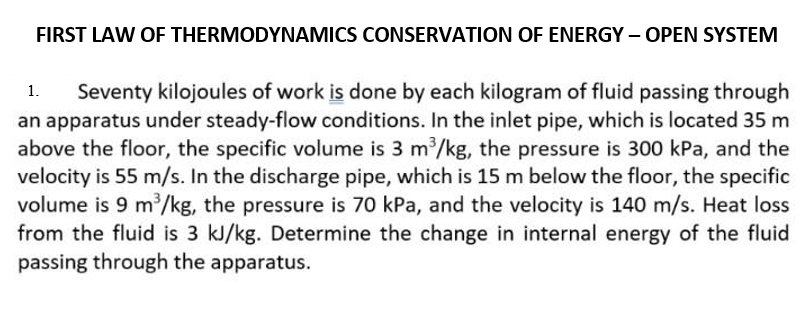Seventy kilojoules of work is done by each kilogram of fluid passing through an apparatus under steady-flow conditions. In the inlet pipe, which is located 35 m above the floor, the specific volume is 3 m/kg, the pressure is 300 kPa, and the velocity is 55 m/s. In the discharge pipe, which is 15 m below the floor, the specific volume is 9 m2/kg, the pressure is 70 kPa, and the velocity is 140 m/s. Heat loss from the fluid is 3 kJ/kg. Determine the change in internal energy of the fluid passing through the apparatus. 1.
Seventy kilojoules of work is done by each kilogram of fluid passing through an apparatus under steady-flow conditions. In the inlet pipe, which is located 35 m above the floor, the specific volume is 3 m/kg, the pressure is 300 kPa, and the velocity is 55 m/s. In the discharge pipe, which is 15 m below the floor, the specific volume is 9 m2/kg, the pressure is 70 kPa, and the velocity is 140 m/s. Heat loss from the fluid is 3 kJ/kg. Determine the change in internal energy of the fluid passing through the apparatus. 1.
Elements Of Electromagnetics
7th Edition
ISBN:9780190698614
Author:Sadiku, Matthew N. O.
Publisher:Sadiku, Matthew N. O.
ChapterMA: Math Assessment
Section: Chapter Questions
Problem 1.1MA
Related questions
Question
FIRST LAW OF
show solution step by step.
answer it in 1hr. please

Transcribed Image Text:FIRST LAW OF THERMODYNAMICS CONSERVATION OF ENERGY – OPEN SYSTEM
Seventy kilojoules of work is done by each kilogram of fluid passing through
an apparatus under steady-flow conditions. In the inlet pipe, which is located 35 m
above the floor, the specific volume is 3 m/kg, the pressure is 300 kPa, and the
velocity is 55 m/s. In the discharge pipe, which is 15 m below the floor, the specific
volume is 9 m/kg, the pressure is 70 kPa, and the velocity is 140 m/s. Heat loss
from the fluid is 3 kJ/kg. Determine the change in internal energy of the fluid
passing through the apparatus.
1.
Expert Solution
This question has been solved!
Explore an expertly crafted, step-by-step solution for a thorough understanding of key concepts.
Step by step
Solved in 2 steps with 2 images

Knowledge Booster
Learn more about
Need a deep-dive on the concept behind this application? Look no further. Learn more about this topic, mechanical-engineering and related others by exploring similar questions and additional content below.Recommended textbooks for you

Elements Of Electromagnetics
Mechanical Engineering
ISBN:
9780190698614
Author:
Sadiku, Matthew N. O.
Publisher:
Oxford University Press

Mechanics of Materials (10th Edition)
Mechanical Engineering
ISBN:
9780134319650
Author:
Russell C. Hibbeler
Publisher:
PEARSON

Thermodynamics: An Engineering Approach
Mechanical Engineering
ISBN:
9781259822674
Author:
Yunus A. Cengel Dr., Michael A. Boles
Publisher:
McGraw-Hill Education

Elements Of Electromagnetics
Mechanical Engineering
ISBN:
9780190698614
Author:
Sadiku, Matthew N. O.
Publisher:
Oxford University Press

Mechanics of Materials (10th Edition)
Mechanical Engineering
ISBN:
9780134319650
Author:
Russell C. Hibbeler
Publisher:
PEARSON

Thermodynamics: An Engineering Approach
Mechanical Engineering
ISBN:
9781259822674
Author:
Yunus A. Cengel Dr., Michael A. Boles
Publisher:
McGraw-Hill Education

Control Systems Engineering
Mechanical Engineering
ISBN:
9781118170519
Author:
Norman S. Nise
Publisher:
WILEY

Mechanics of Materials (MindTap Course List)
Mechanical Engineering
ISBN:
9781337093347
Author:
Barry J. Goodno, James M. Gere
Publisher:
Cengage Learning

Engineering Mechanics: Statics
Mechanical Engineering
ISBN:
9781118807330
Author:
James L. Meriam, L. G. Kraige, J. N. Bolton
Publisher:
WILEY